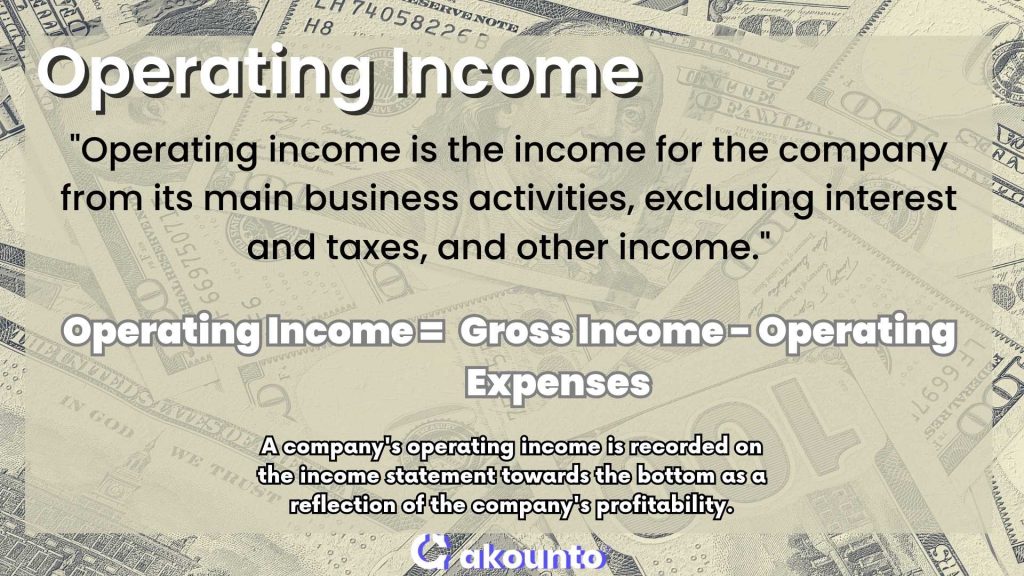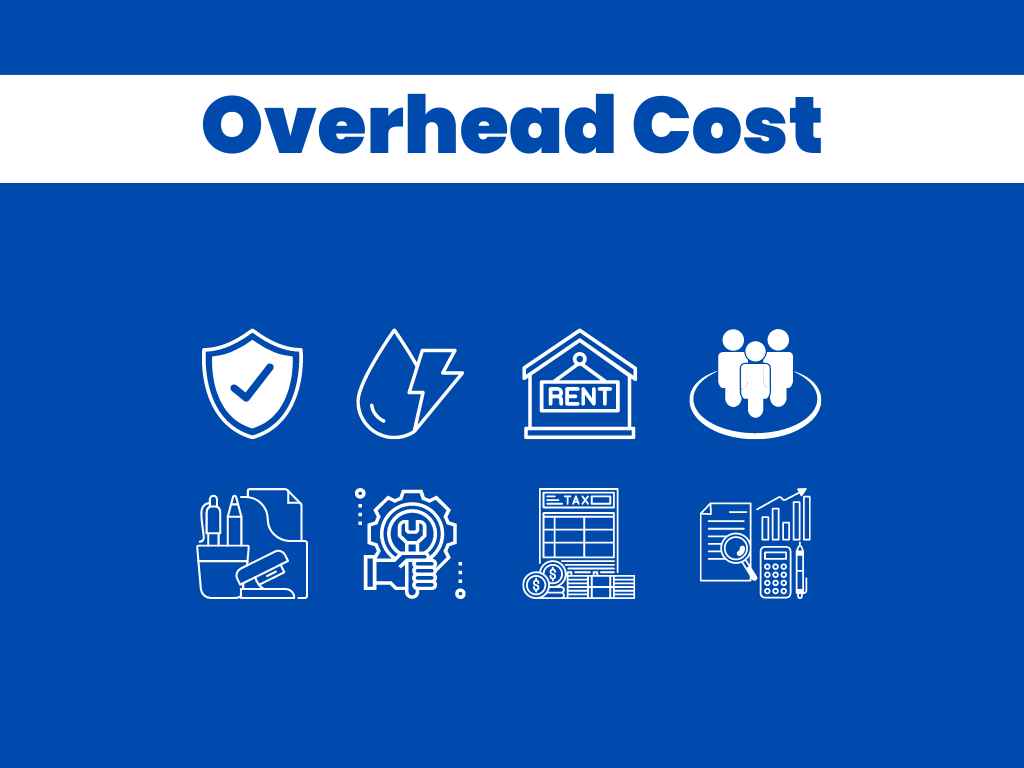What is Operating Income?
Operating income is the income for the company from its main business activities, excluding interest and taxes, and other income.
Operating income measures a company’s gross profit (i.e., total revenue minus the cost of goods sold). It subtracts all operating expenses, including expenses from regular business operations, such as office supplies and utilities.
What’s covered in the article
Determining operating income is essential for several reasons:
- It is a key financial metric, highlighting the business’s capacity to generate revenue from its core operational activities.
- By comparison with gross profit, you can see how well executive management can recover expenses related to running normal operating activities.
- Used to compare the financial feasibility of companies within the same industry, as it reflects their operational efficiency.
- Operating income is also an important metric for investors, as it helps them estimate the potential returns on their investments and make informed decisions.
A company’s operating income is recorded on the income statement towards the bottom as a reflection of the company’s profitability.
Components of Operating Income
Operating income is calculated using the following components from the income statement of a company:
Total Revenue
Total revenue is the total money a company earns from all sources, including the sale of goods or services and any other income, such as investments, interest, or royalties.
On an income statement, the total revenue is calculated by adding all the revenues earned by the company during the specified accounting period.
Total Revenue = Sales Revenue + Other Revenues
Operating expenses (direct and indirect costs), depreciation, and amortization are subtracted from the total revenue to calculate the operating income.
Gross Profit or Revenue
Gross revenue or profit is the total amount of money a company generates from its net sales or services after deducting the direct costs (COGS).
Gross Profit= Total Revenue – Cost of Goods Sold (COGS)
It is important to note that gross profit includes non-operating income and operating income. Unlike operating income, it does not exclude interest payments, taxes, or any indirect expenses.
Cost of Goods Sold (COGS)
Cost of goods sold (COGS) includes the direct costs of producing or delivering a company’s products or services, such as materials, labor, and manufacturing overhead.
When subtracting costs for calculating operating income, interest, taxes, and other indirect costs incurred have to be deducted separately.
Operating Expenses
A company incurs operating costs in its day-to-day operations and includes salaries, rent, utilities, office supplies, and marketing expenses necessary to run a business.
Depreciation
Depreciation is the cost of an asset expensed in a certain period. Depreciation is associated with tangible assets only.
Suppose a company purchases a building for $1 million, with an expected useful life of 30 years. The estimated resale value at the end of 30 years is $200,000.
To compute the annual depreciation expense, the company subtracts the resale value from the original cost and divides the result by the useful life of the building.
($1,000,000 – $200,000) / 30 years = $26,667
The company will expense $26,667 annually for 30 years until the building is fully depreciated.
If a company’s income statement does not include depreciation in the operating expenses column, the depreciation expenses will be subtracted separately for calculating operating income.
Amortization
Amortization is an accounting method that allocates the cost of an intangible asset over the expected period of its usefulness. Amortization is an expense that should be subtracted from the gross income to reach operating income.
A company acquires a patent for $500,000 that has a legal life of 20 years. To calculate the annual amortization expense, the company divides the cost of the patent by its legal life.
$500,000 / 20 years = $25,000
The company will expense $25,000 annually for 20 years until the patent is fully amortized.
A company can find operating income by subtracting the direct costs, i.e., COGS, operating expenses, depreciation, and amortization, from the total revenue.
Operating income represents the profit generated from a company’s core business activities before interest expenses, taxes, depreciation and amortization, and other non-operating items.
Calculation

The formula to calculate operating income is:
Operating Income = Gross Income – Operating Expenses
The formula can be applied using various metrics from a company’s financial statements. You can start from the net profit and subtract the operational costs. Or you can start with the net profit and add the interest expenses and taxes to arrive at the operating income.
Assume Company ABC has prepared an income statement for the fiscal year, and it looks like this:
| Revenue: | |
| Sales | $500,000 |
| Interest Income | $10,000 |
| Total revenue | $510,000 |
| Expenses: | |
| Cost of Goods Sold | $200,000 |
| Selling, general, and Administrative | $100,000 |
| Depreciation | $20,000 |
| Interest Expense | $5,000 |
| Total Expenses | $325,000 |
| Net income | $185,000 |
Operating income can be calculated using three different methods:
Top-Down Approach
Operating income can be calculated by subtracting the expenses incurred during the running of an operation from net profit. The operating costs do not include depreciation and amortization expenses, so they should be removed separately.
The formula for operating income using the top-down approach is:
Operating Income = Gross Profit − Operating Expense − Depreciation Expense − Amortization, where: Gross Profit = Gross Income – Direct Costs
Operating Expenses = Selling, General, and Administrative Expenses (from the income statement)
Depreciation = Decline in value of fixed assets
Amortization = Spread of the cost of intangible assets
Therefore, using the operating income formula:
Operating Income = $300,000 – $120,000 – $20,000 – 0 = $160,000
Among depreciation and amortization, we only have depreciation in the given example.
So, the operating income for this company is $160,000.
The top-down approach is recommended for businesses relying on fixed assets (machinery, vehicles, etc.) to run their operations.
Bottom-Up Approach
We can add interest and tax expenses to the net income to calculate operating income. As net income is the last item on a company’s income statement, and we go from the bottom up for calculating operating income, this approach is called the bottom-up approach.
Start with the net income:
Net Income (Net Earnings) = $185,000
Add back any non-operating expenses, such as interest and taxes, to get earnings before interest and taxes (EBIT)
Net Income + Interest Expense = $190,000
Subtract any non-operating income, such as interest, from EBIT:
EBIT – Interest Income = $180,000
Subtract any taxes from the result to get the operating income:
EBIT – Interest Income – Taxes = Operating Income
$180,000 – 0 – (0.35 * $180,000) = $117,000
For this particular scenario, assume the tax percentage equals 35 %. So, subtracting taxes, we get an operating income of $117000.
The bottom-up approach is recommended for businesses with changing tax rates and a significant income from interest.
Cost Accounting Approach
Using the cost accounting approach, we calculate the gross profit by subtracting direct costs (COGS) from the net revenue.
Sales – Cost of Goods Sold = Gross Profit
$500,000 – $200,000 = $300,000
Then, subtract all selling, administrative, general expenses, and depreciation from gross profit to obtain operating income.
Gross Profit – Selling, General, and Administrative Expenses – Depreciation = Operating Income
$300,000 – $100,000 – $20,000 = $180,000
The gross profit method is helpful for internal use. It provides a clear picture of a company’s profitability by considering all of the costs associated with production, including indirect costs.
The cost accounting method does not include taxes and interest expenses, as they are typically not classified as direct or indirect costs.
Operating profit margin is another important metric that measures operating profit per sale.
Operating margin = Operating Income / Net Sales
Company ABC chooses the cost accounting method to calculate operating income in the above example. On the income statement, the operating income, hence, equals $180000.
The operating profit margin will then be calculated as follows:
Operating Margin = Operating Income / Net Sales = $180,000 / $500,000
Operating Margin = 0.36 or 36%
Therefore, the operating margin for the company would be 36%. It means the company can generate .36 dollars of operating profit for every dollar of revenue generated.
A higher operating profit margin indicates that the company can control its operating expenses effectively and generate a higher yield from its core business activities.
Operating Income vs. Net Income
| Operating Income | Net income | |
| Definition | Operating income measures a business’ profitability from the company’s core business operations. | Net income measures the total amount of profit a company earns after all expenses are deducted from the total sales revenue. |
| Calculation | Operating income is found by deducting operating expenses from gross profit. | Net income can be measured by subtracting all expenses, including non-operating costs such as interest and taxes, from total revenue. |
| Comparability | Operating income is more useful in comparing the profitability of companies and businesses in the same industry. | Net income is a measure of how able a company is to pay dividends and returns to its investors. |
| Focus | Operating income provides insight into the profitability of a company’s core business activities. | Net income provides a comprehensive view of a company’s financial performance, considering all expenses and revenue streams, including those outside of core business operations. |
| Exclusions | Operating income does not consider non-operating expenses such as interest and taxes. | Net income considers all expenses, including non-operating costs such as interest and taxes. |
Steps to Increase Operating Income
Operating income can be calculated simply by subtracting operating expenses from the company’s gross income, but it holds much more important than that as a metric.
A higher operating income is valued as it indicates the profitability and efficiency of the business. That is why it is an important metric to consider for investors.
Here are some steps to increase the operating income:
Reduce Costs
The most obvious way to increase operating income is to reduce the direct and indirect costs associated with the product’s manufacture or service delivery.
Reducing production and operational costs may include:
- Negotiating with suppliers for a better price for raw materials
- Cutting down energy costs
- Managing inventory timely and planning sales to prevent inventory wastage
- Cutting down labor costs on tasks that can be automated
- Downsizing the office space or relocating to a cheaper location
Increase Sales
Increasing sales will increase the net revenue and, ultimately, the operating income. Before working on ways to bring in new customers, focus on retaining the present clientele.
After that, devise a suitable plan for your business to increase your company’s visibility and net revenue. Here is what you can do:
- Conduct thorough market research, and align your product, service, and marketing strategy according to the target audience.
- Expand your product or service offerings to appeal to a broader range of customers.
- Invest in customer service and support to build loyalty and retention.
- Communicate the benefits and value of your product or service to your target market. Highlight what makes you stand apart from your competitors.
Eliminate and Diversify
Eliminate the underperforming and under-valued products that only burden the company’s total operating expenses. Couple this with product diversification to boost net sales, ultimately increasing the company’s profit margin.
By diversifying your product line, you can expand to new markets and expand your customer base. This will also reduce your risk of relying on one product line for the company’s financial health.
Reduce Organizational Drag
One efficient way to boost the operating profit margin is to facilitate staff productivity by reducing organizational drag. According to Harvard Business Review, companies lose more than 20% of their revenue to the processes and structures in the management that hinder them from getting their tasks done.
Automation and streamlining of repetitive tasks can reduce organizational delays significantly. Skip the meetings and discussions that could happen through email. Improving the team productivity can increase the net revenue and hence the operating income on the income statement.
Conclusion
A high operating income on the annual income statements speaks volumes about the business’s viability and executive management’s efficiency. A higher operating income indicates the ability of a business to effectively manage its expenses before relying on other sources of revenue.
Sign up with Akounto to keep track of your interest, taxes, depreciation, and operating income.











